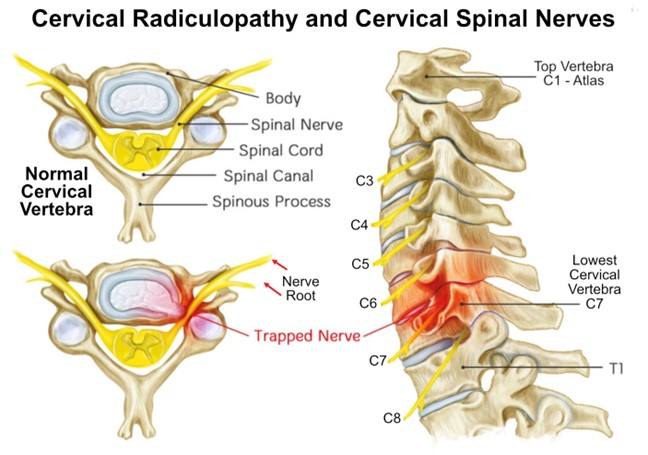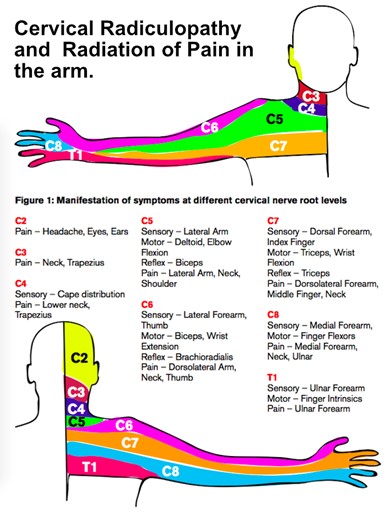
Neck and arm pain – Cervical radiculopathy
This is when a nerve root in the cervical spine or neck is pressured or irritated, with neurological symptoms. It can cause pain to radiate to the shoulder and down the arm, or weakness in the arm or hands with tingling, pins and needles and numbness.
Cervical Nerve Roots and Radiculopathy
There are 8 pairs of cervical nerve roots, C1 to C8, branching from the spinal cord on both sides through an intervertebral foramen – openings between each pair of vertebrae.
The cervical nerves then travel down the arm and branch out to supply strength and movement to the muscles to the shoulders, arms, hands, and fingers. sensory channels in the nerve supply sensation to the skin. The area of the arm affected will depend on the nerve root affected and this is described below in the “cervical radiculopathy radiation of arm pain” chart.
Causes of cervical radiculopathy
Inflammation around the nerve causing a lack of oxygen and damage to the nerve sheaf cells is considered the most commonly likely explanation, or a true mechanical impingement of the nerve root due to a bone spur or cervical disc herniation, either from spinal wear and tear and degeneration or an injury. There are also less common causes, such as infections or tumours.
Who is affected by cervical radiculopathy
It is a rare condition that occurs slightly more often in men than women.
It is more common in older people, due to spinal degeneration. the highest risk is for those aged 50 to 54.
In younger people, it is most likely due to disc herniation or injury.
Cervical Radiculopathy from a Herniated Cervical Disc
Pain commonly appears intermittently, but can develop suddenly or gradually.
Neck extension (putting the head back) can exacerbate the symptoms.
Causes Of Cervical Disc Herniation
- Trauma to the annular fibres
- Repetitive micro trauma to the annular fibres
- Gradual weakening from small strains and postural stress
- See Maintaining Disc Health
A cervical disc prolapse, bulge or herniation can occur, with no pressure on the cervical nerves. This may not give any pain at all, or just simple neck pain. If the nerve exiting the neck is pressured, however…
Examination findings with a Cervical nerve irritation: neurological changes will occur with one or more of the following clinical signs:
- Tendon reflex changes
- Weakness and reduced muscle strength into the arms or hands
- Muscle atrophy if severe
- Reduced sensation, numbness, or hypersensitivity
Chiropractic Treatment of cervical radiculopathy
Chiropractors cannot just ‘put the disc back into place’ but treatment has been shown to reduce pain, promote the healing process and speed up the recovery. A 2006 publication in the journal Spine showed Chiropractic manipulation in the treatment of disc injuries and sciatica had “very good results”.
- Chiropractic manipulation
- Joint mobilization
- Traction and muscle releasing treatments
- Deep massage to the muscular spasms and trigger spots
- Rest or activities to avoid strain
- Avoid Cervical extension or tilting the head back
- Client education; Alexander Technique focusing on neck and head balance and awareness of neck extension, called ‘pulling the head back’, which is very common.
- Ice and/or heat therapy
Manipulation aims for radiculopathy:
- Increase intervertebral space
- Widen cervical neural foramina
- Reduce inter-disc pressure
- Improve blood vascularity to site of injury
Muscular release of the Cervical spine:
Sub-Occipital Release: Chiropractic release using both hands. With fingertips on the base of the patient’s occiput, slow superior traction targeting the fascial tissue plane is applied, asking the patient to relax whilst holding the tender ‘trigger spots’. The fascial release can be felt as the tight connective tissue releases and the pain subsides.
Soft-Tissue massage to the paravertebral muscles along the cervical spine, given to the patients tolerance level.
Cervical traction with trigger point massage contact points to the mastoid processes, occiput, whilst the neck is in slight flexion
Muscle Energy deep cross-friction across the tendon insertions into the occiput and suboccipital muscles, asking the patient to relax whilst breathing
Surgery should only be an option if you do not improve with other care, or if there is an urgent need to do so, for example, if you have compression of the spinal cord causing central stenosis.
How long will it take to get better is a unique process, depending on the duration of the symptoms, the severity of the injury and how well patients can avoid the daily stresses and strains to the neck that aggravate and irritate the condition. Most cases of cervical radiculopathy are self-limiting and go away on their own.
Pain Distribution with Cervical Radiculopathy
The chart below describes the areas of the arm affected with each nerve root, and this can give an indication of the level of the pain.
NEUROLOGICAL DIFFERENTIAL DIAGNOSIS
| CONDITION | SIGNS AND SYMPTOMS |
|---|---|
| Anterior/Posterior Interosseous Nerve Entrapment | Grip/pinch weakness, no pain |
| Carpal Tunnel Syndrome | Thenar weakness, numb in radial fingers, paresthesia |
| Cervical Myelopathy* | Decreased dexterity, lack of finger co-ordination. Urinary urgency |
| Cubital Tunnel Syndrome | Grasp weakness, numbness in 4th and 5th digit, paresthesia |
| Radial Tunnel Syndrome | Pain at radial forearm |
| Brachial Plexopathy | Shoulder pain, paresthesia, numbness |
| Reflex Sympathetic Dystrophy | Pain, edema, skin discoloration |
| Thoracic Outlet Syndrome | Pain, edema, Palpation and Adson’s radial pulse tests |
| NON-NEUROLOGICAL | DIFFERENTIAL DIAGNOSES |
|---|---|
| Ml | CP, Diaphoresis, lightheadedness |
| PE | Hypoxia, Tachycardia, CP |
| Pneumothorax | CP, SOB, tachycardia, tachypnea |
| Spinal Abscess* | Fever, neuro deficit, immunocompromised |
| Extraspinal Malignancy* | Fever, h/o CA, wt change |
| Herpes Zoster | Vesicular lesions, pain along dermatome |
| Rotator Cuff Tendinosis | Pain, edema, skin discoloration |
| Diabetic Radiculopathy | Paresthesia, numbness |
| Thrombosis (Arterial or venous) | Swelling, redness, pain, cool extremity |
